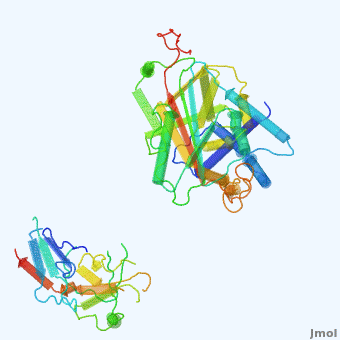Function
Alpha-1-antitrypsin (also known as α1-antitrypsin or A1AT) is an inhibitor of Elastase and Trypsin. It is a member of the Serine Protease Inhibitor (Serpin) family, and as such undergoes a conformational change where the substrate protein associates with a loop region on A1AT causing that loop to become ordered as a Beta Strand[1]. In this case Trypsin (the substrate) is inhibited when a covalent bond is formed to A1AT through the newly formed Beta region[1]. Once bound covalently to its substrate the stability of the A1AT complex goes up drastically, making it an effective "molecular mousetrap"[1]. With A1AT, as with most members of the Serpin family, the transition from inactive precursor protein to active complex comes after a cleavage event[1].
Shown is a morph, generated by the Yale Morph Server that shows A1AT going from its inactive form, to the conformation in which it is bound to Trypsin (also shown in the same animation)[2].
Role in disease
Mutations of MET358 to ARG can lead to a change in specificity in the Elastase binding pocket, essentially turning the M358R mutant of A1AT into a Thrombin inhibitor by generating specificity for this new substrate. This drop in Thrombin levels can lead to hemorrhaging. [3]
A mutation in the genes coding for A1AT known as the "Z-antitrypsin mutation" can lead to formation of an inactive polymer made up of subunits of this protein. This polymer builds up in liver cell endoplasmic reticulums leading to cirrhosis of the liver and emphysema. One explanation for this is that a decrease in the flexibility of A1AT is preventing it from inserting its loop region into the proper region of the same subunit. This model suggests that the loop region of one subunit of A1AT inserts into the middle of another subunit, leading to polymerization. However this method does not explain the excess stability of the complex. An alternative model suggests that this polymerization is the result of domain swapping[1].
Scenes
3D structures of Alpha-1-antitrypsin
Alpha-1-antitrypsin 3D structures

